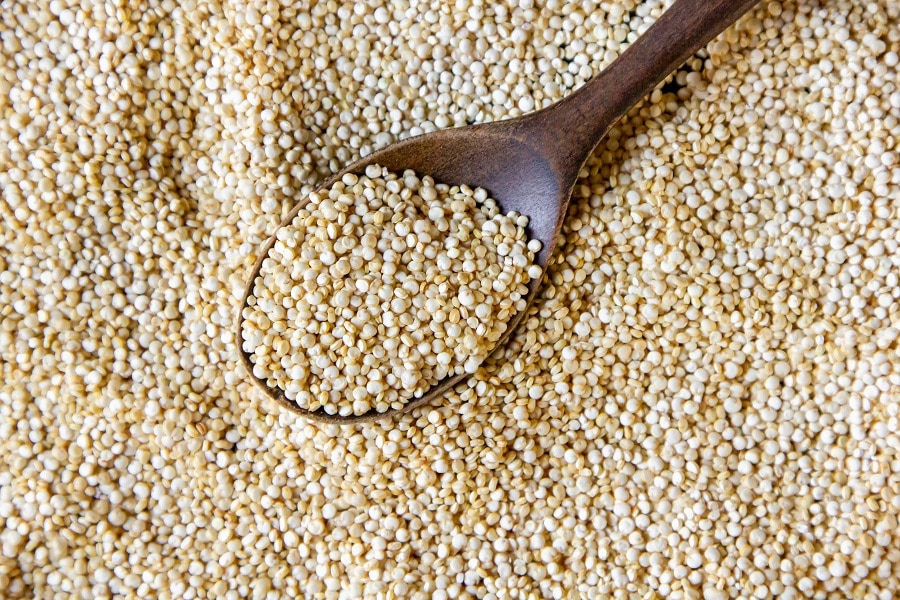NASA mulls feeding it to astronauts on their way to Mars. Vegans love it. Celebrity chefs rave about it. Yet despite booming popularity across the world quinoa remains almost exclusively a staple crop of South America, grown mainly in Peru and Bolivia. It’s a rarity in Africa, even after decades of failed starts to change this.
Why? Scientists think they know the answer: it’s a pain in the neck to work with.
Quinoa has fed Andean farmers for thousands of years. It grows well in a variety of climates and even at high elevations. Quinoa seeds are gluten-free and famously packed with nutrients, especially protein, fat, and dietary fiber. This flowering pseudo-cereal even tolerates droughts and poor soil conditions. Its promise is so great that the United Nations designated 2013 “the international year of quinoa,” directing aid agencies to spread the quinoa gospel far and wide, especially in regions in desperate need of nutritious, healthy food.
Food security advocates keep trying to entice Africa’s farmers to embrace quinoa as their own, convinced it can help solve hunger and malnutrition. Vumilia Zikankuba wants to see her native Tanzania embrace quinoa in a big way. Yet it’s been an uphill climb for her.
“The crop is not known in Tanzania; awareness is very low,” said Zikankuba, a researcher at the Horticulture Research and Training Institute-Tengeru. “There have been no trials to yet grow quinoa in Tanzania, although it has a lot of potential and there’s a need to adopt functional and adaptive crops in Tanzania and Africa at large.”
Field trials were attempted in neighboring Kenya in the 1990s and Malawi in the 2010s, she said, with mixed results. The UN Food and Agriculture Organization led an experiment to cultivate quinoa in Burkina Faso during the 2015-2016 growing season. Despite setbacks by fungi infections, pests, and lodging, FAO deemed the trials successful. Yet quinoa did not take off in West Africa.
In Malawi researchers encountered the same issues with pests and diseases, but determined these were manageable and not a major barrier to wider quinoa cultivation on the African continent. Scientists say the crop is both culturally acceptable and adaptable to local cuisines. A 2015 study on the Malawi effort led by Center for Advanced Studies in Arid Zones, an agricultural research institute based in Chile, argued quinoa should already be spreading like wildfire throughout Africa since it is very similar to rice and millet. After all, other South American foods have been wildly popular among African farmers, especially potatoes and maize, they noted. But Africa’s farmers continue to shun quinoa, preferring more traditional staples.
So why are Africa’s farmers turning up their noses at quinoa? “The limiting factor is the energy requirement for using water (not readily available in the dry season) and for mechanical threshing,” the Center concluded in its study.
And therein lies the answer, Zikankuba agrees. “100% this”, she said, switching to more colloquial language to illustrate her point. Quinoa is bitter if cooked straight off the plant. You take care of this bitterness by removing the seeds’ outer coating. This outer shell can be washed off with water, but the seeds must then be immediately dried afterwards, otherwise you risk seeing them inadvertently germinate. You can also scrub the bitter coating off without water. This process is cheaper, but also a lot more work.
With either process, quinoa requires extra attention and care to make it edible. Andean farmers have grown accustomed to this extra burden through thousands of years of tradition and experience. Africa’s farmers aren’t there yet, so they stick to standard crops like maize that don’t require any of this additional effort. “This is among the reasons the community opts for foods other than quinoa,” Zikankuba explained. “It’s the nature of bitterness and the ease of preparation.”
Zikankuba is convinced quinoa can be harnessed to solve a host of dietary challenges in Tanzania and throughout Africa. But she fears quinoa won’t take off on the continent as she hopes until someone engineers a cheaper, easier, and energy-light means of processing this potentially game-changing crop.
“Affordable and effective technology for processing is vital to promoting quinoa production and consumption in Africa,” she said.
Processing technology might be a bit outside of what most agricultural scientists do, but it’s vital work that Grow Further might support if someone comes along with a big idea.
–Grow Further




